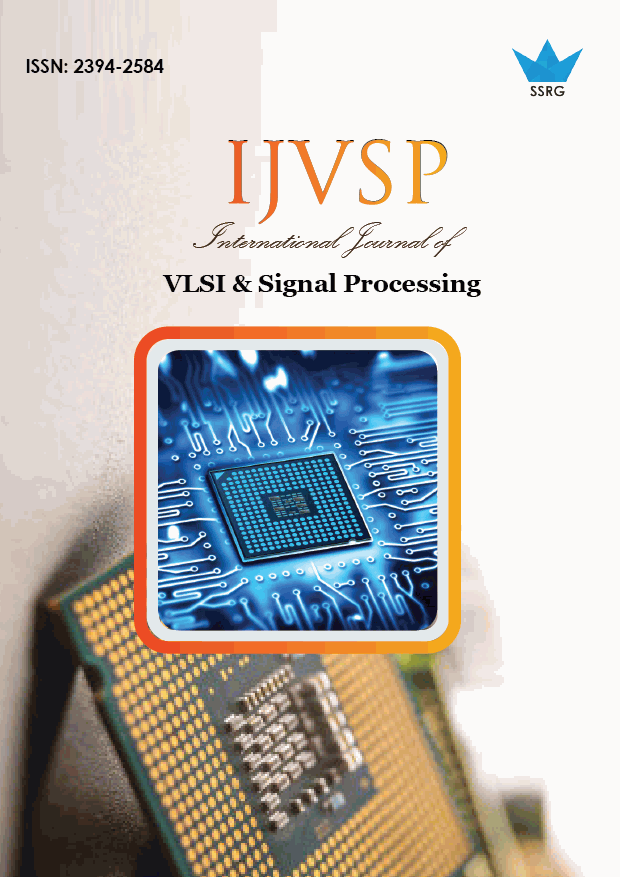A Review on ASIC Flow Employing EDA Tools by Synopsys

| International Journal of VLSI & Signal Processing |
| © 2020 by SSRG - IJVSP Journal |
| Volume 7 Issue 1 |
| Year of Publication : 2020 |
| Authors : Neha Deshpande, Sowmya K B |
How to Cite?
Neha Deshpande, Sowmya K B, "A Review on ASIC Flow Employing EDA Tools by Synopsys," SSRG International Journal of VLSI & Signal Processing, vol. 7, no. 1, pp. 15-19, 2020. Crossref, https://doi.org/10.14445/23942584/IJVSP-V7I1P104
Abstract:
The development in automation tools and their algorithms has made it convenient to design ASIC processors and perform extensive analysis of their parameters. Application Specific Integrated Circuit (ASIC) design flow provides the flexibility of modeling the blocks as hardware accelerator which can be made a part of the chip. In ASIC flow there are various processes like logic or physical synthesis, static timing analysis, formal verification, design for testability which provides details about area, power, timing information, violating paths that required for designing the block to so that it can be integrated into the chip along with other blocks. In regard to this, the paper provides an insight to the brief literature survey of the proposed works, their functioning with respect to Synopsys’s EDA tools and the dependency between these tools. Thus, the methods used in the flow are designed such that the critical parameters of the design like power, area and timing can be optimized to a great extent with the aid of EDA tools.
Keywords:
Application Specific Integrated Circuit, Register Transfer Logic, Electronic Design Automation, Design Compiler, Prime Time, IC Compiler, Synthesis, Timing Analysis, Floor planning, Optimization, Power, Area.
References:
[1] S. Gayathri and T. C. Taranath, "RTL synthesis of case study using design compiler," 2017 International Conference on Electrical, Electronics, Communication, Computer, and Optimization Techniques (ICEECCOT), Mysuru, 2017, pp. 1-7.
[2] S. Iyengar and L. Shrinivasan, "Power, Performance and Area Optimization of I/O Design," 2018 International Conference on Inventive Research in Computing Applications (ICIRCA), Coimbatore, 2018, pp. 415-420.
[3] S. Hsiao, M. Tsai and C. Wen, "Low Area/Power Synthesis Using Hybrid Pass Transistor/CMOS Logic Cells in Standard Cell-Based Design Environment," in IEEE Transactions on Circuits and Systems II: Express Briefs, vol. 57, no. 1, pp. 21-25, Jan. 2010.
[4] A.Yadlapati and H.K. Kakarla, ―Low-power design-for-test implementation on phase-locked loop design,‖ Measurement and Control, June 2019. [5] F. M. Jumaah, S. Baskara, R. M. Sidek and F. Z. Rokhani, "PrimeTime web-based report analyzer (PTWRA) tool," 2015 6th Asia Symposium on Quality Electronic Design (ASQED), Kula Lumpur, 2015, pp. 203-208.
[6] K. P. Ghosh and A. K. Ghosh, "Technology mediated tutorial on RISC-V CPU core implementation and sign-off using revolutionary EDA management system (EMS) — VSDFLOW," 2018 China Semiconductor Technology International Conference (CSTIC), Shanghai, 2018, pp. 1-3. [7] S. Karapetyan and U. Schlichtmann, "Integrating aging aware timing analysis into a commercial STA tool," VLSI Design, Automation and Test(VLSI-DAT), Hsinchu, 2015, pp. 1-4. [8] H. Kalargaris, Y. Chen and V. F. Pavlidis, "STA compatible backend design flow for TSV-based 3-D ICs," 2017 18th International Symposium on Quality Electronic Design (ISQED), Santa Clara, CA, 2017, pp. 186-190.
[9] S. Sreevidya, R. Holla and R. Raghu, "Low Power Physical Design and Verification in 16nm FinFET Technology," 2019 3rd International conference on Electronics, Communication and Aerospace Technology (ICECA), Coimbatore, India, 2019, pp. 936-940.
[10] L. M. K. Garimella and S. R. S. Garimella, "Novel 3D Monotonic Characterization of Standard Cell Liberty File Attributes w.r.t ASIC Tool Flow," 2018 IEEE 61st International Midwest Symposium on Circuits and Systems (MWSCAS), Windsor, ON, Canada, 2018, pp. 771-774.

 10.14445/23942584/IJVSP-V7I1P104
10.14445/23942584/IJVSP-V7I1P104